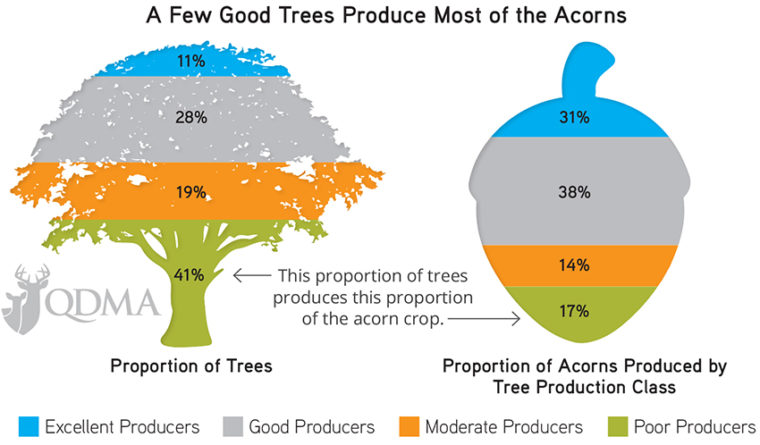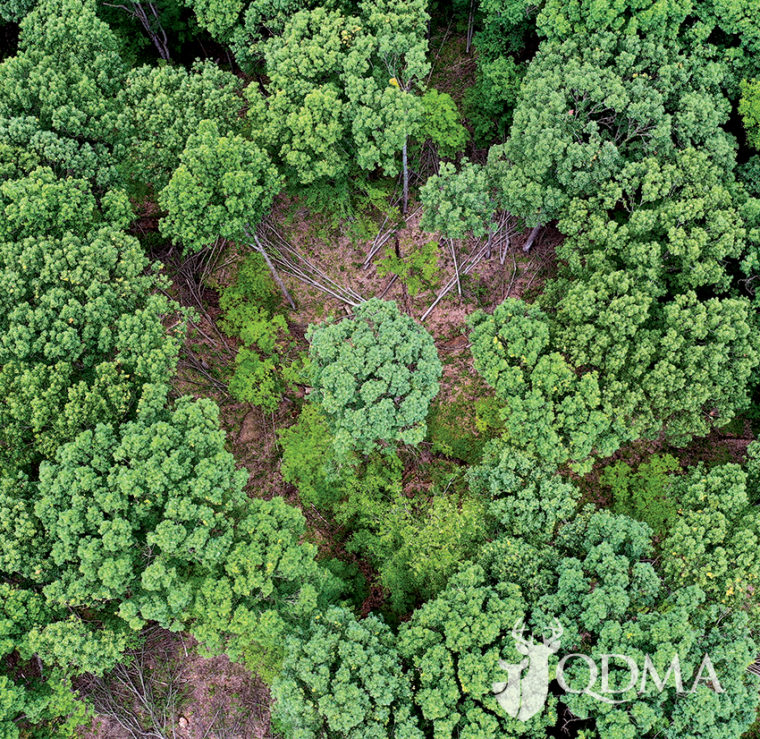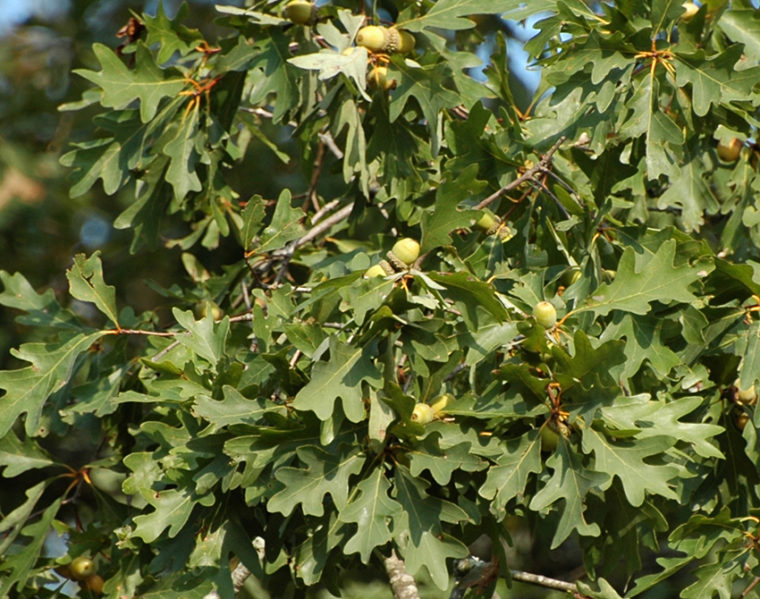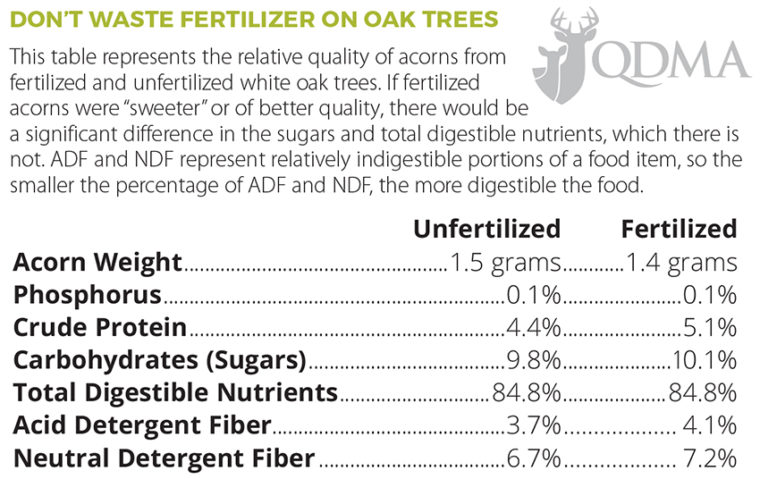Acorns. If you are a deer hunter in a forested area of the eastern United States, it is likely you consider them a crucial factor in deer management. It is likely they influence your hunting strategy. In fact, you probably have killed lots of deer that were eating them, so there is logic as to why you place great importance on them. This positive association may have even influenced your perception on how deer habitat should be managed.
How many times have you heard you shouldn’t cut trees, especially oaks, because that will reduce the amount of food for deer? We’ve heard it a lot! Many people are so infatuated with acorns that they fertilize the trees, believing they will not only increase acorn production but also make the acorns “sweeter.” And they didn’t dream this up. It is actually stated in advertisements of various products. However, could this association with acorns actually be detrimental with regard to reaching your deer management goals? Could some hunters be blinded by wanting too much of good thing, failing to see the value of having less? We believe so. We believe it is time for hunters to reconsider acorns, think about their relative importance when managing habitat for deer, and evaluate which management practices are effective and which are folly.
We need to consider forage and browse production as the nutritional baseline, and any acorn production simply as a periodic bonus.
Acorns are relished by deer. When acorns drop, deer gravitate to them. Acorns of some white oak species, such as Quercus alba, are particularly selected because they are relatively low in tannins and are naturally sweeter – actually less bitter – than other acorns. However, deer may eat acorns of red oaks as readily as they do those of white oaks if white oak acorns are not available. Acorns have very high nutritional value for deer and other wildlife. Acorns contain more energy than corn, two times the amount of carbohydrates, and up to 10 times the amount of fat, making acorns a tremendous food source for many wildlife species during fall and winter.
Given this, shouldn’t we protect all of our forested acreage and try to promote acorns as much as possible? In a word, no. There are limitations and other factors that must be considered.
Deer grow body mass, give birth, and produce antlers during spring and summer, not fall and winter when acorns are available. Deer require lots of nutritious green forage during the growing season to meet the demands of growth and lactation. If those requirements are not met, deer are smaller, antlers are smaller, and fawns may die of starvation because the doe is not able to produce enough milk or the fawns are weakened and more vulnerable to predation. This scenario is common in many areas across the eastern United States. The nutritional requirements of deer during spring and summer are limited in most forests across the East because a closed canopy prevents sufficient sunlight from reaching the forest floor to stimulate the super-nutritious, shade-intolerant forbs deer select over anything else at that time of year.

White oaks only produce an abundant acorn crop two out of every five years. Some years they produce none. The data in this chart were collected at Chuck Swan State Forest and Wildlife Management Area in east Tennessee.
Perhaps the biggest limitation regarding acorns is inconsistent production. We cannot count on an abundant acorn crop. Oak tree species are separated into two groups, white and red, and both groups contain many species. We manage for a variety of oak species from both the white oak group and the red oak group in our forests and woodlands to increase chances for acorn production across years. However, there still are about as many years with few to no acorns as there are years with abundant acorns. Weather, which influences pollination, is the primary determinant in acorn crop consistency. We can only count on an abundant white oak acorn crop about two years out of five (see the chart above). So, how intelligent is it to maintain large areas of a property in a closed-canopy forest that produces exceptionally little food for deer while they are growing and does not consistently produce food during fall and winter?
The crowns of trees you release from competition often increase in size by 25% in the first year, which allows them to produce greater than 50% more acorns per tree. That is significant.
At this point, you need to consider just how much forest you really need to meet your objectives, and how you manage your forested acreage to get as much out of it as possible. At the same time, you must consider how much open land you need to provide deer with sufficient forage in spring and summer, which is determined by your objectives and the condition of the deer. To maximize the nutritional carrying capacity (NCC) for deer on your property, you need to consider how open land can provide much more high-quality forage than forests, and open land should be dispersed across the property. Your objectives, as well as the current NCC of the property, help determine how you should manage your woods. Allowing more sunlight into the forest and releasing the crowns of those trees you favor also can increase the NCC. Allowing as little as 30% sunlight into a previously closed-canopy forest typically increases deer forage availability seven to eight times in those areas where canopy coverage was reduced. And the crowns of those trees you release from competition often increase in size by 25% in the first year following treatment, which allows them to produce greater than 50% more acorns per tree. That is significant.

More than 100 white oaks were evaluated for 10 years and rated as excellent, good, moderate, or poor acorn producers. A small portion of the trees were responsible for a majority of the acorn crop. As you can see in this diagram, 39% of the oaks (excellent and good trees) produced 69% of the acorns.
As you kill or fell trees to allow more sunlight into the woods, it is important to realize that a relatively small percentage of the individual oak trees produce the majority of acorns. In fact, about 40% of the trees produce about 70% of the acorns. If you walk through your woods during a good acorn-production year, you can mark those trees that have produced lots of acorns. Ideally, you should do this over a few years so you can identify good-producing trees from both the white oak and red oak groups. So, not only can you kill or fell relatively unimportant non-mast producers, you also could kill or fell up to 50% of the oak trees (the poor producers) and still increase overall acorn production in the stand!
What about fertilization to increase acorn production? It doesn’t work. Period. You will waste lots of money and time, and you’ll break your back carrying loads of fertilizer into the woods for no benefit. It is time to put this notion to bed. The next time you see an advertisement or hear a salesman promoting fertilizer to increase acorn production, simply ask for a copy of the data and analysis showing how fertilization has increased acorn production or made them sweeter. We have shown you our data here. Why won’t they show you theirs? Because it doesn’t exist. We have asked.
Thinning forests provides great benefits for deer. Not only can you increase forage and mast production, but you also enhance fawning cover greatly. Does on a higher nutritional plane produce more milk for fawns, and fawns have better cover to hide in. However, the benefit is relatively short-lived without management. As increased sunlight is allowed into the woods, tree seedlings and sprouts respond quickly, growing out of reach of deer and shading out the more nutritious forbs growing in the understory within six years. Periodic prescribed fire, spot-spray herbicide applications, or continued chainsaw work is necessary to maintain sufficient sunlight, understory groundcover and increased NCC for deer.

“Crown release” refers to the removal of competing trees around an oak that has been selected for improvement efforts. In experiments, crown release produced a 65% increase in acorn production compared to untreated trees. Fertilized oaks did not produce more acorns than untreated trees. Meanwhile, the additional sunlight admitted into the forest will increase understory forage, soft mast and fawning cover.
Deer eat acorns. Indeed, deer relish acorns, so much so that acorn availability influences deer movements. And we like to hunt near oaks that are dropping acorns like rain because we are likely to see deer coming to those trees. However, we shouldn’t be blinded by an inconsistent food source that does not provide nutrition during spring and summer when deer are growing. Instead, we should improve our management to provide the food and cover deer require throughout the year as if there was no such thing as an acorn. We need to consider forage and browse production as the nutritional baseline, and any acorn production simply as a periodic bonus. When properties are managed as such, there is no reduction in deer body weights or in percent body fat during poor acorn years. We realize such an approach is a great departure from the current thought process of many of you who live in big woods country. However, it is curious that when we ask you to name three states that you would like to hunt, Kansas is mentioned every time. Think about that!
About the Authors: Dr. Craig Harper is the Extension Wildlife Specialist and professor of wildlife management at the University of Tennessee. Jarred Brooke is the Extension Wildlife Specialist at Purdue University. The information in this article is based on research by the authors and others at the University of Tennessee.

